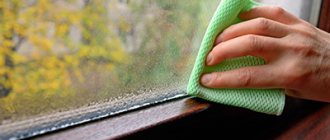Home » Building a house
Vladimir 03/23/2020
42371 Views 2 comments
Plastic windows are completely sealed and can guarantee warmth and comfort in your home. The only problem associated with their tightness is when the windows sweat. Why does condensation appear and how to prevent windows from fogging up?
What is the problem
What is the problem with foggy windows anyway? In general, condensation appears on windows as a result of a sharp temperature change. Conventional physics can explain this, or rather the transition of a liquid from a gaseous to a liquid state.
When there is a lot of vapor in the air, it turns into liquid when it collides with cold surfaces. The coldest point in the house is the window, so that's where condensation appears.
The windows are foggy from the outside. This situation is extremely rare
Oddly enough, windows can fog up in different ways.
Here are some of the most common scenarios:
- Condensation appears with the onset of cold weather. This situation is the most common; condensation forms when the temperature drops to a certain level. When the air temperature rises, the windows stop sweating
- The windows are sweating in the kitchen. This is natural, because the kitchen is constantly cooking. The temperature in the room is constantly changing, which leads to fogging of the window
- The window only sweats in one room. This problem occurs due to certain features of the room itself, or due to problems directly with this window
- The window only sweats in the morning. Closer to lunch, the condensation completely disappears, and the window remains dry
Is it possible to solve the problem of moisture?
The problem of fogging of translucent elements inside a double-glazed window can be solved by completely replacing the double-glazed window . To do this, a new window unit is ordered from the factory, which is installed in place of the dismantled element.
If there is no technical or material possibility of replacing an entire part of 2 or 3 glasses, it is possible to use more gentle methods related to sealing the glass unit around the perimeter or changing the temperature and humidity parameters in the room being used.
Important. Experts do not recommend resorting to simple solutions, since these measures are only temporary. After a certain period of time, the problem occurs again, which will ultimately require window replacement.
When is it impossible without radical methods?
In some cases, the problem cannot be solved by simple repairs , and the owner of the premises is forced to replace the entire double-glazed window or adjacent structural elements:
- When a double-glazed window delaminates due to a violation of the adhesive bond between the profile and the translucent element along the perimeter.
- In the case of ice formation between the glass panes with further expansion of the crystallized liquid medium, which causes deformation of the framing aluminum profile of the glass unit.
- If there are cracks, chips and other defects on the surface of the glass as part of the window block.
Solving the problem without purchasing a new double-glazed window is impossible if there is a manufacturing defect associated with depressurization of the double-glazed window.
In such cases, if the window was installed relatively recently,
experts recommend contacting the manufacturer .
He is obliged to provide a free product with the same dimensions and thermal properties, even if the warranty period for the result of window installation has already expired.
As a rule, when selling double-glazed windows, each manufacturer guarantees at least 25–30 years of flawless operation of their products.
Why do windows sweat?
To understand how to solve the problem of window fogging, you need to find out what reasons can lead to this.
Flowers on the windowsill are one of the most common causes of condensation on windows
As a rule, this problem manifests itself for a number of the following reasons:
1 High level of humidity in the room. This problem often causes kitchen or bathroom windows to fog up. If there is high humidity in the room, condensation will form on the windows. Frequent cooking leads to a worsening of the situation, faulty ventilation or hood, drying clothes after washing.
2 Poor circulation of heat from various heating sources. This problem most often occurs in the fall or spring, when it is still cold and humid outside and the indoor temperature is not warm enough. Warm air does not enter the lower part of the window sill, especially if it is wide, and condensation forms in this place.
3 Incorrectly installed windows. Experienced installers carry out this work in accordance with all standards, so no problems arise. Those who charge less for work cannot guarantee a high-quality result; they are usually in a hurry and perform the installation with deviations from the norm. In such situations, the structure is not completely sealed, and cold air can penetrate into the middle of the room. Another problem during installation is level mismatch. Over time, the window frame warps and the seal is broken. This can cause problems not only in the formation of condensation, but also in the operation of the window as a whole: opening the sash, operating the fittings, etc. If you install it yourself, the scenario is approximately the same, without experience, if something goes wrong you won’t even be aware of this before the first signs of a problem appear.
4 Poor quality glass unit. This problem also often arises due to the desire to save money. Poor insulation or faulty fittings in windows allow cold air to enter, causing condensation to form.
5 Double-glazed window. This is the so-called cold glazing system, which is used only for non-residential premises. This design does not have sufficient thermal insulation properties, which leads to the appearance of condensation.
6 The fittings are not adjusted correctly. During seasonal temperature changes, the profile can expand and contract. Therefore, window fittings are adjusted according to the season. Otherwise, the seal of the window may be broken and it will begin to sweat.
7 The insulation has worn out or was initially of poor quality. All window structures are equipped with a seal, which is located along the contour of the sash. It tends to wear out or harden over time. In cheap models this happens faster, so the window “sweats”.
8 Clogged drain holes. You can find them at the bottom of the opening sash. Their purpose is to allow water to flow down the outside of the glass when the sash is in ventilation mode. When the drainage holes are clogged, water flows onto the windowsill indoors.
9 Plant on the windowsill. If the flowers are very close to the window, there is a high probability that condensation will begin to form. Plants release moisture or it evaporates after watering.
Reasons for fogging of plastic windows
There can be many reasons why plastic windows sweat from the inside. And to eliminate the problem, you cannot do without identifying the causes. So, the problem may occur due to:
- Increased humidity in the air in the room - for example, when cooking, drying clothes, and so on.
- Air circulation problems in the apartment. If in winter the radiators are only slightly warm, and it is very cold outside, then the plastic windows cannot be heated to the proper extent.
- If the radiators are hot and the windows still fog up, you need to check the window sill - it may turn out that its overhang is too large and blocks the flow of heat to the window area. Protective screens on batteries can also lead to this - because in this way the heat spreading throughout the apartment does not cover the lower part of the window, which is why condensation forms here.
- Lack of high-quality ventilation - it may become clogged or not work at all, so moist air cannot be extracted.
- Plastic windows may fog up if the apartment or balcony is being renovated, or immediately after it is completed. After all, all freshly laid finishing materials (wallpaper and even ceramic tiles) release a large amount of moisture into the room, which will settle on the windows.
Incorrect installation of a plastic window. This means that your windows were installed with a gross violation of technology - poor-quality sealing of the gap between the profile and the window opening.
In addition, the low tide is very often installed incorrectly - it is simply screwed to the window. The ebb should be placed on a pre-prepared mortar base - this will create a sealed layer, protect it from moisture and cold, as well as from noise in case of strong wind.
The window can also be installed out of level - the resulting misalignment leads to the fact that the sealing gaskets of the window sashes do not fit tightly.
Low-quality fittings can also play a role - because of them, the window sashes will not close tightly. Fittings installed in violation of the rules will have the same effect.
Improper performance of work on insulation of external or internal slopes. They definitely need to be insulated and this should be done efficiently.
Foam plastic is suitable as external insulation. You should also use cement mortar - it is used to seal the cracks where the window meets the opening. When working with internal slopes, foam plastic is not used - here preference is given to basalt slabs or glass wool (mineral insulation).
Poor quality seal - then a gap appears between the glass unit and the frame through which cold air passes.
Incorrect adjustment of a plastic window - insufficient fit of the sashes, incorrectly installed fittings, and so on.
Dew point concept
Dew point is the temperature at which water changes from a gaseous state to a liquid. This point is located in the thermally insulating layer of the wall, and is located at different levels in different situations. This point cannot be detected visually; it is only marked on the graph.
The dew point is directly proportional to the humidity level in the room
The most important rule is that condensation forms due to temperature and humidity. The lower the humidity in the room, the lower the dew point.
Factors that influence dew point:
- outside temperature
- wall thickness
- room temperature
- indoor humidity
- humidity outside
Causes of window fogging
Excessive moisture should be named first. A person himself evaporates about 2–3 liters of water per day. And this is on average under normal conditions. Living plants in pots also produce moisture.
If we talk about an apartment or house, then the microclimate is also affected by using a washing machine, cooking, taking a bath or shower. The relative humidity in residential premises should be in the range of 50-65%.
In connection with the first point, the question arises as to why excess water remains in the room. Apartments and houses usually do not have good ventilation. Fresh air enters there through windows and doors and moisture is removed in the same way. This, as can be seen from practice, is not enough.
Temperature change. People notice condensation on plastic windows mostly during the cold season or in the off-season. Why is that? Condensation is equally affected by both humidity and temperature.
There is such a concept - dew point. This is the temperature at which the vapor contained in the air collects into droplets of water, since the air cannot hold it. The glass surface is the coldest place in the house.
At a sufficiently high relative humidity, when the temperature of the glass inside the room reaches a certain level, it passes the dew point and we get condensation on the windows. A demonstration of this phenomenon can be a glass vessel taken out of the refrigerator - the same processes occur with it.
Another factor that is directly related to temperature is the location of the house according to the cardinal directions. Windows facing north will certainly be colder than those facing south.
Accordingly, the moisture that has already formed on them will evaporate much longer, which means it will have a longer effect on the double-glazed window itself.
Why do you need to remove condensate?
Complete sealing of plastic windows can disrupt the natural microclimate in the room. While wooden structures can “breathe,” completely sealed PVC windows prevent natural air circulation.
Condensation is one of the reasons for the appearance of fungus
If condensation forms on the windows, then the microclimate in the room is unfavorable for human health. Because of this, pathogenic bacteria, fungus and mold can develop in the room.
For a person, ideal living conditions are considered to be 20-22 degrees Celsius and 30-45% humidity in the room. Condensation on the windows is the first sign that the atmosphere in the room does not meet these requirements. To return a favorable atmosphere to the room, this problem must be eliminated.
Plastic windows leak when it rains
If it happens that during rain water flows through plastic windows, and you don’t know what to do. Don’t rush to panic, we will help you fix this problem and tell you why moisture is getting in.
Reasons for window leaks:
- Installation errors. Most likely, even when installing the window, the technology of insulation and sealing of seams was violated and because of this the plastic window is leaking.
- The seal has lost its properties, has become depleted, and has dried out. But this only happens if the sealing rubber has been in use for a long time.
- Incorrectly made slopes.
- There is a small amount of foam in the openings or it is of poor quality.
- The drainage is poorly inserted, or it cannot cope with such a volume of water, or it is completely clogged.
- In addition to the leakage of a plastic window during rain, there is another cause for concern - rubbing and fogging of the glass from the inside, the appearance of condensation.
Reasons for the appearance of moisture inside PVC windows:
- Poor quality glass. Often, unscrupulous manufacturers make it from cheap and low-quality materials; subsequently, the double-glazed window does not fully perform its heat-protective function, the glass freezes and condensation appears.
- Insufficient ventilation. You just need to skillfully use the microventilation mode, ventilate the rooms regularly, 10–15 minutes of ventilation per day will be enough.
- Increased humidity in the house. Especially in the kitchen, while cooking or boiling water.
- Incorrect installation, the window is blown out in places and moisture loss is inevitable in winter.
- If a window leaks during renovation, this is normal, because building materials contain moisture and gradually release dampness to the air.
Condensation and wooden windows
As a rule, in houses with wooden windows the problem of fogging is not known. This is due to the structure of the wood itself, which allows air to circulate and they are not as airtight as plastic ones. This way the room maintains a normal level of humidity.
Wooden windows rarely sweat, but if this problem occurs, immediate action must be taken
Modern window designs are completely sealed. On the one hand, this is good, because the room becomes much quieter and warmer after their installation. This prevents air from circulating as it was originally intended.
To get rid of condensation, sometimes it’s enough just to ventilate the room daily. This will help natural air circulation and prevent fogging. In addition, some modern window systems have special channels for micro-ventilation. But wooden windows can also sweat, but why does this happen?
Why do wooden windows sweat?
Using a fan heater, you can blow off foggy windows
As in other cases, the first reason for the formation of condensation is excess humidity in the room. If the air humidity is more than 50%, this is immediately reflected in fogged windows.
To get rid of condensation on the windows, arrange for them to be blown with warm air. To do this, you can use a heat gun, fan heater, air dehumidifier, etc.
Incorrect installation of radiators can also cause this problem. If the radiator is located far from the windows, it will most likely not be possible to completely get rid of the appearance of dew. For normal air circulation, the radiator will have to be placed in the correct place. In addition, a cold wall that is not heated by a radiator will also cause frost to form on the window.
Condensation between glasses, what to do
If condensation at the bottom of a plastic window, or along its entire surface on the inside of the window, is a common occurrence, then fogged windows from the inside are much less common. Most often this occurs due to depressurization of the structure.
Condensation inside the glass unit
This may happen for the following reasons:
- The product was released with a defect . This happens when they want to save money when purchasing and buy windows from an untrusted manufacturer. Another reason may be a violation of window manufacturing technology.
- window damage during transportation . If, during transportation of the product, chips or cracks appeared on the window, the gas or compressed air that fills the space between the double-glazed windows could escape. It could also be possible to remove the layer of sealing sealant.
- if the owner of the windows carries out some manipulations with the product , disassembles them and puts them back together, the gas also comes out, and after assembly it was not sealed back. If a glass unit was disassembled, its original properties were lost in 90% of cases
If condensation begins to form between the glasses, the only solution is to completely replace the double-glazed window with a new one. A professional can replace a double-glazed window in just half an hour, but you can do this work yourself. In addition, a new double-glazed window is not expensive at all.
Why is condensation dangerous?
If plastic structures begin to fog up, it may seem unpleasant, but it is harmless. In reality, everything is not quite like that. Excess moisture spreads from the glass to the window sill, walls, and ceiling. In such conditions, fungi and microorganisms thrive very well, including many that are dangerous to humans. In a warm, humid environment, they quickly multiply and “spread” around the room.
Allergy sufferers and people with respiratory diseases will feel especially bad in such conditions. But that is not all. Damp construction and finishing materials swell and begin to collapse. Sometimes this process goes very quickly; after just a few months, a good repair becomes unusable.
- Cleaning
Caring for plastic windows: 7 things no one does
Useful tips on how to deal with condensation
Regular ventilation is important to prevent “dew on the windows” and for human health.
Sometimes a problem catches you by surprise, and you have to look for a solution literally on the fly.
If for some reason it is not possible to find the root of the problem, professionals recommend preventing window fogging using the following recommendations:
- If condensation appears on your windows, first of all you should remove all plants from the windowsill. Plants evaporate moisture, which is when problems arise.
- Ventilate your apartment regularly. Spend 10-15 minutes daily on this, let it become a kind of ritual
- You need to install a hood in the kitchen. With its help, most of the moisture that appears during cooking will be absorbed. This will help reduce the humidity level in the room itself and prevent condensation. You also need to adjust the draft of the device; if it is too strong, the result may be the opposite.
- Windows need to be inspected regularly for damage. Carefully check the fittings once a year and the seals for wear. If necessary, faulty parts must be replaced
- Once a season, the fittings must be switched to winter or summer mode
- try to increase the air temperature in the room. In some situations, this is enough, and when the temperature stabilizes, condensation stops forming
- make a window sill already. This is relevant if “dew” appears mainly at the bottom of the window. This means that the heat from the battery does not reach this area
- make an additional hole for ventilation under the window sill. It must be end-to-end. Additional ventilation will increase air circulation and possibly prevent condensation.
Ventilating the room can not only help combat condensation, but will also be beneficial for the health of the inhabitants of your home.
The causes of condensation can be completely different. In some cases, the problem is minor, for example the same flowers. Therefore, before taking drastic measures, it is worth taking these preventive actions.
What does constant moisture on glass lead to?
Very damp windows are common. The appearance of condensation is not only an aesthetic problem. It should not be neglected for the following reasons:
- the degree of illumination decreases;
- dampness spreads over all surfaces.
A serious decrease in the level of room lighting negatively affects vision, immunity and leads to the development of clinical depression.
Too high humidity causes the proliferation of pathogens, bacteria and fungi. In the process of their life, they produce spores. Over time, people living in such premises begin to experience health problems.
Dampness has a negative effect on finishing materials. An example is the appearance of black or green spots, destruction of the structure of the plaster, and a decrease in the strength of load-bearing elements. It is difficult to eliminate the consequences; cosmetic repairs often have to be made.
Most often, humidity rises on a balcony or loggia. This is due to the fact that cold air enters the room through the walls and floor. The windows will not fog up until the room is insulated. Otherwise, mold and mildew will appear on the walls, and it will not be comfortable to use the balcony in winter.
Almost every home has electrical equipment. Too high humidity negatively affects their condition; the electrical cable also suffers, which will have to be replaced more often than in a room with a dry microclimate.
To eliminate the possibility of a problem occurring, you need to choose the right window. Classification is carried out according to the following criteria:
- the material used to create the frame and fittings;
- the principle of operation of the valves;
- installation location;
- frame shape.
At the time of diagnosis, the main factor taken into account is the installation location. Dormer windows fog up most often, which is due to the climate that forms in the attic. In this case, special solutions are selected and installed.
Various materials are used in the manufacture of sashes. When choosing double-glazed windows based on this criterion, the following are taken into account:
- Wooden windows look much more attractive, but they are inferior in terms of airtightness. Therefore, they often experience the appearance of moisture between the valves. If the room is too humid, wooden double-glazed windows are not suitable.
- Plastic ones are the most common; polyvinyl chloride is used in their manufacture. This material does not react to moisture and has a dense structure. Therefore, moisture does not penetrate into the space between the doors.
- Metal-plastic ones are installed extremely rarely. This frame is much stronger than the plastic or wooden type, but is extremely unstable to moisture and is characterized by high cost.
The reason for the flooding of wooden window structures is that during the winter period the natural material collects a large amount of moisture. As the temperature rises, the natural exchange of air is disrupted.
In the case of PVC, all problems are easily solved. This is due to the fact that the frames are made of a cellular structure, which does not allow air and moisture to pass through. However, if there is no air circulation, even in this case water will appear between the doors or on the inside.
The technical characteristics of metal-plastic are in no way inferior to the PVC version. In this case, the causes of condensation are the same as with plastic windows. The solution to the problem in winter is “volley” ventilation of the room.
Rarely does glass fog up on the outside. This occurs due to strong temperature changes. This problem cannot be eliminated if we are talking about unheated rooms; in others, the flow of hot air is directed to the surface of the glass.
Mold is a companion of foggy windows, what to do about it
Mold must be dealt with immediately
One of the most unpleasant consequences of frost on windows is mold. If you do not pay attention to the formation of condensation and start the problem, this can lead to more serious consequences, or rather, fungus and mold. And what to do when the slopes are covered with mold?
When you notice the appearance of black spots around the windows, you should take care of removing this plaque. To do this, you can use various chemical compounds, including bleach or an alcohol solution. After removing plaque, you need to make it a rule to regularly ventilate the room. Such precautions are taken only in winter.
With the onset of warmer weather, it is necessary to take more serious measures and completely remove mold-affected areas of plaster and replace it with new one. After the new layer has dried, it must be treated with an antiseptic.
How to get rid of condensation using traditional methods
To combat condensation, you can use traditional methods. They are more gentle on the structure itself, but these methods effectively cope with the problem.
Method 1
An old and proven way to deal with “dew” and ice on the window is a candle.
An ordinary wax candle can help in the fight against fogging of windows. It works in the case of double-glazed windows and the formation of frost on the windows. This method has been used for several decades; this method has been used to remove ice from windows. Several candles are placed on the windowsill along its entire length. They warm up the glass and prevent ice from forming.
Many people recommend using thick candles. They burn slower and will last longer. At the same time, with the help of such candles you can “brighten up” the interior of the room a little, making it more comfortable. If desired, candles can be scented.
When a candle burns, it releases carbon dioxide. If there are indoor plants on the windowsill, this can be an excellent feed for them, and you won’t have to remove the flower pots.
Method 2
Properly washed windows will prevent condensation from forming. But for this you need the right solution
Sometimes cleaning your windows properly can help. Depending on the original cause of condensation, sometimes this is enough. Of course, the “success” of such a struggle can be expressed in varying degrees, but sometimes it helps.
For washing you need to use:
- soft, lint-free cloth
- microfiber cloth
- newspapers for wiping
- soap solution
- glycerol
- alcohol (you can use vodka)
- shaving foam
- car window anti-fog spray
- rubber scraper
A window with a fatty layer is most likely to fog up. That is why the “fight” against condensation must begin by cleaning the windows with alcohol.
This will degrease the surface, and the work is carried out as follows:
- first of all, the windows need to be washed in the usual way using a soap solution
- glass must be wiped dry with a lint-free cloth
- remove remaining moisture from the surface using a rubber scraper
- Alcohol is applied to the sponge and the entire surface of the glass unit is treated with it.
- waiting for the window to dry completely
This way, the surface of the window will be completely degreased, which will prevent condensation from forming for some time.
Anti-fog saline solution
The saline solution is applied to a pre-washed window
1 You need to prepare the solution itself. To do this, take 4 liters of water and dissolve 1 tbsp in them. l.
2 Wash the glass in advance with a soap solution , and after it dries, apply the solution evenly.
If there is too much salt, white streaks will remain on the glass after drying. In this case, the entire procedure will have to be repeated from the very beginning.
Glycerin solution
It will be no less effective in case of fogging.
To do this you will need:
- Alcohol and glycerin are mixed in a ratio of 10/1.
- The solution is applied to a previously cleaned glass surface and left for some time. After some time, the alcohol will disappear, and the glycerin will remain on the surface of the glass as a protective film.
Potassium oil, glycerin and turpentine
First you need to prepare the solution itself.
To do this, mix:
- 40 g potassium oil
- 4 g pine turpentine
- 20 g glycerin
The mixture will be quite thick, but it must be applied to pre-washed glass using a sponge. Apply the product in an even layer, distributing it over the entire surface. Using a woolen cloth, polish the glass until it shines.
Method with newspaper
Cleaning a window with newspaper
Many generations before us used crumpled newspapers to clean windows. They help to completely clean the glass surface from dirt and soap stains.
At the same time, few people know about the “miraculous” property of printing ink, which gives the treated glass a water-repellent effect:
- wash windows with soapy water
- start polishing them with crumpled newspaper
Chalk
Chalk solution (you can use tooth powder, it must be white), dilute it with water and treat the pre-washed window. After treating the surface, it must be washed to prevent streaks from appearing.
Step-by-step instructions for installing a window valve
If the window frame is not equipped with a supply valve, you can install it yourself . To do this you will need (depending on the valve design):
- Electric drill and drills 5-10 mm .
- Jigsaw.
- File.
- Shoe knife.
- Sealant.
- The valve itself.
In addition, you will need a template for marking the frame crossbar .
Procedure:
Step 1. Prepare the necessary tools, as well as components for the valve itself.
Simple valve assembly
Step 2. Attaching the template to the crossbar, draw the outline of the hole for the supply valve.
We define the contour according to the template, in the center of the window
Step 3. Make through holes along the contour, which, using a jigsaw, are connected into a solid rectangular cutout.
Cut a through hole, strictly according to the template
Step 4. Use a file to straighten the edges of the hole.
If the jigsaw file is sharp, the edges will already be quite clean
Step 5: Install the valve mounting strip. It is attached with self-tapping screws to the overlap (quarter) of the window crossbar from the inside.
Installing the valve strip
Step 6. From the outside, install the outer part of the valve, equipped with a visor. Fastening with self-tapping screws and sealant.
The external visor is installed as sound insulation
Step 7. Secure and adjust the inside of the valve.
We complete the valve installation
You should work carefully and without haste, carefully monitoring the condition of the glass unit.
Anti-fog chemicals
Window cleaner “Sekunda”
Folk remedies do not always help as much as they should, and then you have to look for other ways to combat this problem. Modern household chemicals are another simple way to combat window fogging.
All chemicals that are designed to combat condensation work on the same principle. The composition is applied to the glass surface and left for a certain amount of time (which is indicated on the packaging; this period is different for all products). After this, wipe the window dry using a lint-free rag.
Tested chemicals:
1 "Li-lo." An effective remedy for fogging and freezing of windows. The product is very concentrated, so you must wear gloves when working. You can buy it at most hardware stores. Apply a thin layer of the product to the surface of the glass; for this you can use a dish sponge. After this, you need to treat the surface a second time with the already diluted product. We dilute “Li-lo” with water in a ratio of 10/1. Without washing off the previous layer, apply the diluted product and do not wash off. We are waiting for it to dry completely.
2 "Second". The product is sold in aerosol form, making it much easier to apply. It is evenly sprayed over the surface in several layers. After this, the glass must be thoroughly wiped with newspaper.
How to wipe windows to prevent sweating inside in winter
To eliminate condensation, you need to choose the right window demisting agent:
- A wax candle is the most common folk remedy for normalizing the climate in a room. Place several candles on the windowsill so that they continue to burn all day and warm the glass. Due to air convection from the flame, condensation does not settle on the glass. As a result of the combustion procedure, carbon dioxide, which is beneficial for plants, is released, so the greens can be left on the windowsill. Pay particular attention to safety and remove items that could easily catch fire.
- Soap . “Rub” a mesh with small cells on the glass with toilet soap. Smear the marks until shiny with a clean microfiber cloth.
- Glycerin . Combine ethyl alcohol with glycerin until smooth in one container, based on the proportions 20/1. Pour the composition into a spray bottle and treat the glass. Polish any stains dry. When the processing is completed, the alcohol will evaporate, and a thin film of glycerin will remain on the glass for a long time.
- Shaving foam . Squeeze a thin layer of foam or gel onto the glass, wipe with paper or a napkin until it shines.
- Dry windows can be wiped with the pulp of half a cut lemon , after which the surface is treated dry with a towel.
- Salt . A cloth bag filled with salt is placed between the doors. The grains will absorb excess moisture well.
- Toothpaste . Apply toothpaste to a sponge or microfiber cloth and vigorously wipe the glass dry. You can also clean the surface with tooth powder.
Important! It is better to burn thick scented candles that burn for a long time and bring a touch of comfort to the interior of the room.
A little about window ventilation
The same comb on the window
As mentioned above, most often the most effective way to combat the formation of frost on glass is high-quality ventilation. The window structure must be equipped with ventilation.
- Windows with a window. Today, windows with a window are extremely rare; they are made only according to the individual orders of the buyers themselves. But this design is most effective in combating condensation. The flow of cold air from the street is easily regulated; it penetrates into the room at the top of the room, where it combines with warm room air. This improves the microclimate in the room.
- Micro-ventilation. It has already been mentioned before, now let’s look at this method of ventilation in more detail. This is the name of the ventilation mode, which is found in almost all modern window designs. The window opens just a little, leaving a small gap through which air exchanges. Through this gap, a lot of cold air will not be able to penetrate into the room, so ventilation in this mode will not bring discomfort to the inhabitants of the house, even in cold weather.
- Self-ventilation. This function is initially present in all window designs. It consists of many small holes in the lower and upper frames of the window. Air circulation eliminates fogging, cold air enters in the lower part, and air leaves the room through holes in the upper frame.
- Combs on the windows. A comb is an accessory for plastic windows that can be purchased at any specialized store. It helps regulate the intensity of ventilation and opening of the sash.
- Ventilation duct. Many people neglect to install it right away, and install it only after a problem appears. Such a ventilation duct is installed either under the window sills or in the profile itself. The devices are completely different. The cost of such a channel is quite high, so ventilation installation should be done by a professional.
Installation errors
- Errors when making an assembly seam: incomplete foaming, which reduces heat transfer resistance; poor protection from external climatic influences, which leads to foam blowing or getting wet; absence or poor vapor barrier, which also leads to the insulation getting wet, but with steam from the side of the room.
- “Cold bridge”, when, due to improper design of the junction unit, the window ends up in a cold, sometimes even negative temperature zone of the wall. This reason often occurs when heavy condensation appears.
- Blowing through a wall structure, for example, a brick one, through empty seams - “empty space”. This phenomenon can be encountered in houses of the socialist period - the builders did not fill the vertical seams well. But this has also become a problem in new construction with multi-layer walls, when the mineral wool is covered on the outside with brick or other cladding. In this case, the insulation must be ventilated, and when the windows are placed in the plane of the insulation, they may be exposed to cold air from the side of the junction. In this case, during installation, it is better to separate the wall from the junction unit with a layer of foamed polyethylene 6-10 mm thick.
- A wide window sill prevents the convection of warm air from the radiator in the window opening.
Therefore, we can give the following tips to eliminate the possibility of condensation:
- If, after all, condensation is a consequence of increased air humidity, then this cause must be eliminated due to the increased likelihood of mold appearing in the room.
- To reduce indoor air humidity and move the dew point to lower temperatures, we recommend installing a Regel-Air climate valve or ventilating the room for 10 minutes twice a day.
- Heat losses with such ventilation are insignificant even in winter and amount to no more than 3 degrees.
- The intensity of ventilation of the room must be increased during repair work.
- The window sill should not be very wide and prevent the passage of warm air.
- To allow warm air to pass through to the window, place the curtains at some distance from the window sill.
- Decorative screens on heating radiators should not interfere with the passage of heat flows from the radiators.
- It is necessary to periodically check the exhaust ventilation system in your home or apartment.
One of the most effective ways to combat condensation will be to install a window with a five-chamber “Favorit” system, developed (Germany) specifically for Russia.
The temperature on the inner surface of the profiles directly depends on the heat transfer resistance of the profile system. For example, we can consider two cases - at an external temperature of -26? C and at -31? C (at an internal temperature of +20? C and a relative humidity of 55%).
The dew point will be +10.7?C. Temperatures on the surfaces of a standard binding (three chambers and a width of about 60 mm) and a five-chamber binding with a heat transfer resistance of 0.78 m2? C/W will be as follows:
| Binding option | Temperature on the binding surface at an outside temperature of -26 C | Temperature on the binding surface at an outside temperature of -31 C |
| Binding with 0.63 m2 C/W | 11.82 C | 9.79 C |
| Binding with 0.78 m2 C/W | 13.22 C | 12.48 C |
Source: ashdom.ru/articles/fenstr_1.htm
Other ways to eliminate condensation
Convection screens will help in the fight against condensation
But chemistry and folk remedies are not all that help cope with the problem of window fogging.
Of the other methods, the most effective are:
- Using a fan, you can create air circulation in a room near a window. The device is placed on one of the window sills, and its direction should preferably touch several window sills at once.
- Convection screens. This is a special device that directs a flow of warm air to the window and prevents condensation from forming. These screens need to be installed at an angle of 30-60 degrees. If the method turns out to be effective in your case, the device can be decorated in accordance with the overall interior of the room.
- Electricity against dew on windows. This method is considered extraordinary, but in most cases effective. Foil, nichrome thread, or other material that conducts current is attached around the perimeter of the entire window. They operate at a voltage of 12-24 W. This solution warms the windows and prevents condensation from forming.











